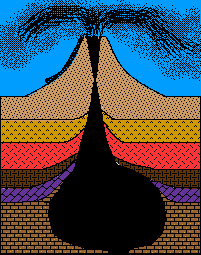
Potassium-Argon Dating Potassium-Argon dating is the only viable technique for dating very old archaeological materials. Geologists have used this method to date rocks as much as 4 billion years old. It is based on the fact that some of the radioactive isotope of Potassium, Potassium-40 (K-40) ,decays to the gas Argon as Argon-40 (Ar-40). By comparing the proportion of K-40 to Ar-40 in a sample of volcanic rock, and knowing the decay rate of K-40, the date that the rock formed can be determined.
How Does the Reaction Work?
Potassium (K) is one of the most abundant elements in the Earth's crust (2.4% by mass). One out of every 10,000 Potassium atoms is radioactive Potassium-40 (K-40). These each have 19 protons and 21 neutrons in their nucleus. If one of these protons is hit by a beta particle, it can be converted into a neutron. With 18 protons and 22 neutrons, the atom has become Argon-40 (Ar-40), an inert gas. For every 100 K-40 atoms that decay, 11 become Ar-40.
How is the Atomic Clock Set?
When rocks are heated to the melting point, any Ar-40 contained in them is released into the atmosphere. When the rock recrystallizes it becomes impermeable to gasses again. As the K-40 in the rock decays into Ar-40, the gas is trapped in the rock.
The Decay Profile
In this simulation, a unit of molten rock cools and crystallizes. The ratio of K-40 to Ar-40 is plotted. Note that time is expressed in millions of years on this graph, as opposed to thousands of years in the C-14 graph. Click on the "Show Movie" button below to view this animation.
How are Samples Processed?
Clicking on the "Show Movie" button below will bring up an animation that illustrates how a K-Ar sample is processed and the calculations involved in arriving at a date. This is actually a mini-simulator, in that it processes a different sample each time and generates different dates.
Limitations on K-Ar Dating
The Potassium-Argon dating method is an invaluable tool for those archaeologists and paleoanthropologists studying the earliest evidence for human evolution. As with any dating technique, there are some significant limitations.
Links
Helpful References
|
|
|
|